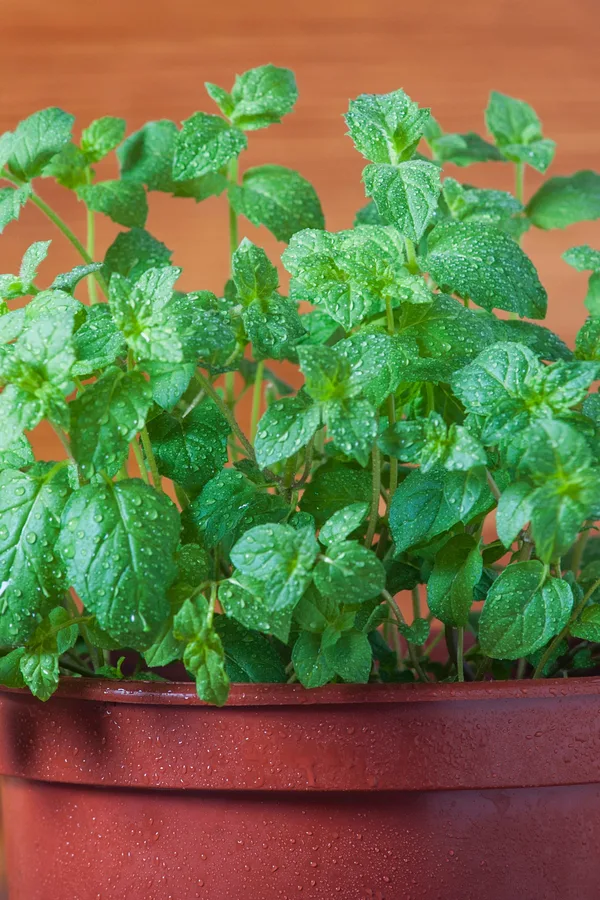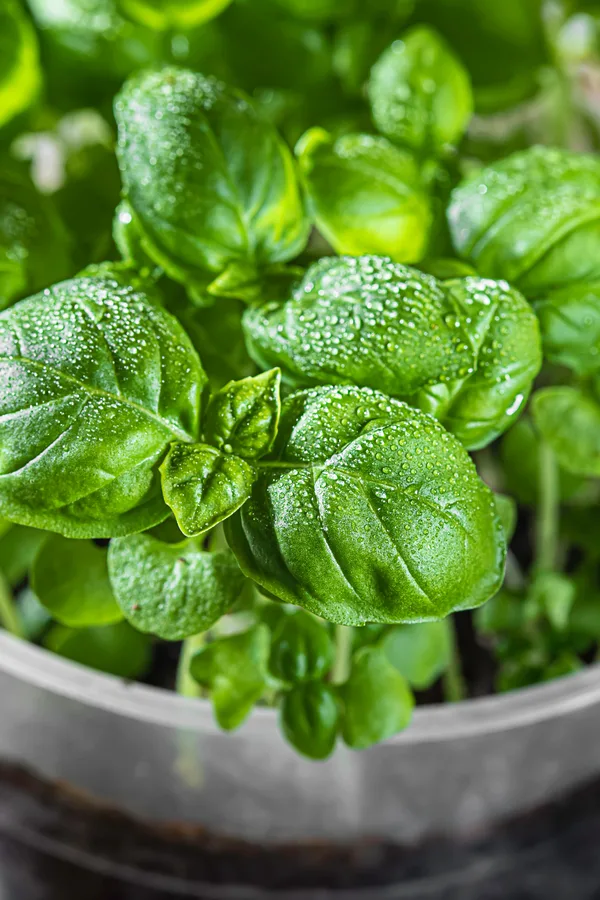There is no better way to continue using and enjoying the fresh herbs you have been growing this summer than by potting them up and bringing them inside to grow through the long winter months.
Herbs are among the easiest of all culinary plants to grow indoors. Especially when they are already thriving, healthy and strong from a full summer of growing outdoors.
Unlike tomatoes, cucumbers and many other vegetable plants, most herbs require far less light to continue to grow and produce inside.
In fact, a large portion of both annual and perennial herbs can grow easily with nothing more than a sunny windowsill or a well lit room providing enough light for success. Even better, they can keep on growing and producing all the way through the coldest of winter months!

How To Bring Herbs Inside
Perennial Herbs
How you bring your herbs inside for the winter all depends if they are perennial or annual plants. For most perennial herbs, the process is easy. You simply start by dividing off a healthy section of an existing plant to re-pot into a smaller vessel. This creates a more manageable new start that requires far less soil, and has plenty of room to grow.
The list of perennials that can grow indoors is actually quite long and impressive. Mint, thyme and chives are all excellent choices. All require very little in the way of soil resources and are quite resilient to missing a day or two of watering here and there as well.
Other perennial herbs that grow well inside are oregano, parsley (biennial) and marjoram. All transplant fairly easily, and like the herbs mentioned above, require little to maintain.
The one perennial herb that can be a bit tricky is rosemary. Rosemary can grow indoors, but it needs a fair amount of light to do so. It can also be finicky to start indoors via transplant or by seed.

Repotting Before A Frost Or Freeze
The secret to success for saving your herbs all begins with potting them up before a hard frost or freeze stunts their growth. Once a perennial herb encounters deep cold, it will begin to go dormant. And bringing it out of that dormancy inside can often be a difficult task.
If you have cold temps in the forecast, take time to get out and dig off a portion to bring inside. At the very least, keep any plant you would like to save covered on cool nights until you can get to them.
Digging Up Perennial Herbs – Bringing Herbs Inside
The process of digging up and repotting perennial herbs is simple and quick. For plants in the ground, select a small portion around the edges for repotting. These areas usually have the least age, and are easy to separate from the main plant. There is no need to dig up the entire plant.
Using a sharp shovel, slice down to remove a two to three inch section of the plant, roots and all. Make sure you are cutting back far enough to get a good section of the root ball and not just the top foliage. A Hori-Hori garden knife, with its sharp serrated edge is great for this task!
Always be sure to refill the area you excavated the new start from back in with soil. This helps to protect the existing roots of the perennial herb for winter. It also provides fresh soil for the roots to expand into as it grows again next spring and summer.
Repotting Perennial Herbs – Bringing Herbs Inside
Now it is time for repotting! Select a container that is about 25 to 50% larger than your root ball. This keeps the pot small enough for a windowsill, but still allows the roots enough room to expand and grow through winter.
Before repotting, make sure your pots will fit on your windowsill if that is where you will be growing. There is nothing worse than potting everything up and then having no place to put them! When repotting, use a high quality, lightweight potting soil. This will allow for easy growth and a much quicker establishing of the roots into the soil.
There is no need for fertilizing or using potting soil with built in fertilizers. Herbs require little in the way of additional nutrients beyond good potting soil.
Finish by watering the roots in well, and placing your newly potted herbs in the brightest, warmest location you can find. Sunny windows work well, as do large rooms with plenty of ambient light from large windows.
If you plant early enough in the fall, you can keep your newly potted plants outdoors to help get them off to a great start. Then, as the weather cools, bring them in overnight to help them adjust to the indoors.

How To Add To Your Herb Collection This Fall – Bringing Herbs Inside
One final tip when it comes to growing perennial herbs indoors for winter – If you don’t happen to have the herb already growing, late fall is a great time to purchase a small start from a local nursery or plant store.
Many growers will put their herbs up on clearance in late fall. They simply don’t want to have to take care of the plants through winter. The best part of all, purchase a small pot and all of the “repotting” work is complete!
Simply take it home, take it inside, and enjoy the harvest while it grows. Next year, all you have to do is take the plant outside, and you can continue to enjoy it all summer and for years to come.
Bringing Annual Herbs Inside For Winter
Now let’s take a look at growing annual herbs indoors. With annuals, the process can be a bit different for winter growing.
A few annual herbs, especially when small and compact, can be dug up and safely brought indoors in late fall. Small seedlings, or late season just-sprouted volunteer plants of basil, dill and cilantro all fall into this category.

Many times, at the end of the growing season, these herbs have reseeded themselves naturally with small starts around the main plant. These are perfect for replanting.
Unfortunately, most mature annuals simply do not respond well at all to transplanting. Once they are plucked from the ground, their large roots make it hard for them to adapt. This doesn’t mean these annual herbs can’t be grown indoors. Instead, either look for young volunteers coming up, or start them from seed.
Of all annual herbs, basil is probably the most popular, and unfortunately, it is the hardest to grow. Much as with rosemary, it may need additional “artificial light” if there is not enough natural light.
But where there is a will, there is a way. A few extra hours each day under a grow light, or even an LED or fluorescent bulb can make all the difference! Here is to bringing your herbs inside this year, and enjoying fresh greenery and flavor all winter long!
Jim and Mary Competti have been writing gardening, DIY and recipe articles and books for over 15 years from their 46 acre Ohio farm. The two are frequent speakers on all things gardening and love to travel in their spare time.
As always, feel free to email us at thefarm@owgarden.com with comments, questions, or to simply say hello! You can sign up for our free email list in the subscribe now box in the middle of this article. Follow us on Facebook here : OWG Facebook. This article may contain affiliate links.
